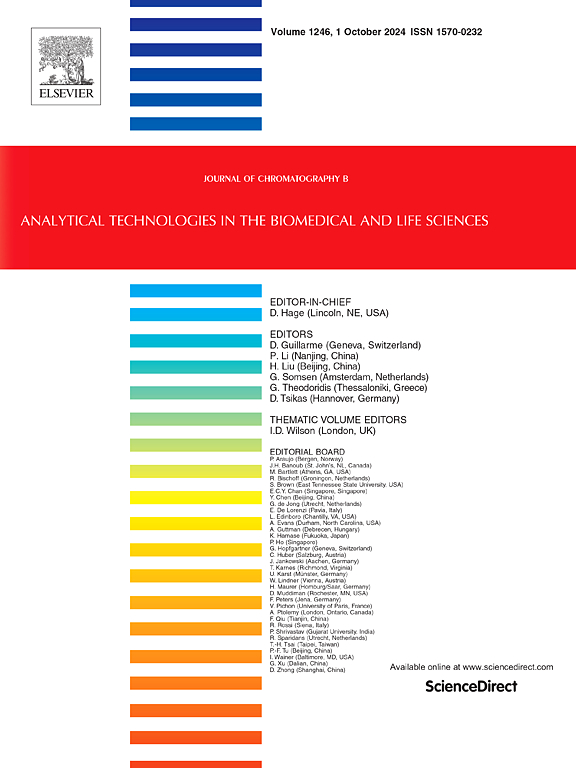金刚石电极电化学检测高效液相色谱法测定血浆中的二硫和二硫代氨基甲酸二乙酯
IF 2.8
3区 医学
Q2 BIOCHEMICAL RESEARCH METHODS
引用次数: 0
摘要
双硫仑(DSF)是一种被批准用于治疗酒精中毒的药物,作为一种抗炎药,通过抑制细胞质front,一种常见的趋化因子受体CCR2和CCR5信号的调节因子,越来越受到人们的关注。虽然测定生物体液(特别是血浆)中的DSF对评估药物疗效很重要,但DSF被白蛋白快速降解往往会影响其准确性和可重复性。本研究采用高性价比、高选择性、高重复性的高效液相色谱法(HPLC)对DSF及其代谢物二乙基二硫代氨基甲酸酯(DDTC)进行定量分析。无白蛋白溶液中DSF的HPLC-ECD定量限为0.04 μg/mL;然而,在加DSF的血清中未检测到DSF。DSF代谢产物游离DDTC和白蛋白结合DDTC两种形式经碘化甲酯处理检测为甲基DDTC (MeDDTC)。HPLC-ECD法测定甲腈和血清中MeDDTC的定量限分别为0.41 μg/mL和1.22 μg/mL。大鼠口服DSF (1000 mg/kg)至48 h后检测血浆MeDDTC。该结果表明,金刚石电极的HPLC-ECD可用于监测血浆中DSF的MeDDTC。本文章由计算机程序翻译,如有差异,请以英文原文为准。
Determination of disulfiram and diethyldithiocarbamate in plasma by high performance liquid chromatography with an electrochemical detection using a diamond electrode
Disulfiram (DSF), a drug approved for the treatment of alcoholism, has been increasing attention as an anti-inflammatory agent via inhibit cytoplasmic FROUNT, a common regulator of chemokine receptor CCR2 and CCR5 signaling. Although the determination of DSF in biological fluids, particularly plasma, is important for evaluating drug efficacy, rapid degradation of DSF by albumin often interferes with its accuracy and reproducibility. In this study, cost-effective, selective, and reproducible high-performance liquid chromatography (HPLC) using an electrochemical detector (ECD) equipped with a diamond electrode was used to quantify DSF and its metabolite, diethyldithiocarbamate (DDTC). The limit of quantification (LOQ) for DSF in an albumin-free solution using the HPLC-ECD method was 0.04 μg/mL; however, DSF was not detected in the serum spiked with DSF. Two forms of DSF metabolites, the free and albumin bound forms of DDTC, were detected as methyl-DDTC (MeDDTC) by methyl iodide treatment. The LOQ of MeDDTC in acetonitrile and serum determined using the HPLC-ECD method were 0.41 μg/mL and 1.22 μg/mL, respectively. Plasma MeDDTC was detected in rats that were orally administered DSF (1000 mg/kg) up to 48 h after treatment. This result suggests that HPLC-ECD with a diamond electrode is useful for determining MeDDTC for DSF monitoring in plasma.
求助全文
通过发布文献求助,成功后即可免费获取论文全文。
去求助
来源期刊

Journal of Chromatography B
医学-分析化学
CiteScore
5.60
自引率
3.30%
发文量
306
审稿时长
44 days
期刊介绍:
The Journal of Chromatography B publishes papers on developments in separation science relevant to biology and biomedical research including both fundamental advances and applications. Analytical techniques which may be considered include the various facets of chromatography, electrophoresis and related methods, affinity and immunoaffinity-based methodologies, hyphenated and other multi-dimensional techniques, and microanalytical approaches. The journal also considers articles reporting developments in sample preparation, detection techniques including mass spectrometry, and data handling and analysis.
Developments related to preparative separations for the isolation and purification of components of biological systems may be published, including chromatographic and electrophoretic methods, affinity separations, field flow fractionation and other preparative approaches.
Applications to the analysis of biological systems and samples will be considered when the analytical science contains a significant element of novelty, e.g. a new approach to the separation of a compound, novel combination of analytical techniques, or significantly improved analytical performance.
 求助内容:
求助内容: 应助结果提醒方式:
应助结果提醒方式:


